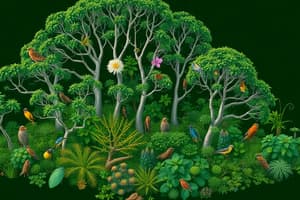Podcast
Questions and Answers
How did pest control programs targeting prairie dogs in North American prairies impact plant communities?
How did pest control programs targeting prairie dogs in North American prairies impact plant communities?
- They eliminated a dynamic influence, reducing plant diversity. (correct)
- They promoted colonization by invasive plant species adapted to disturbed areas.
- They led to an increase in plant diversity due to reduced competition.
- They had no significant impact because burrowing gophers filled the ecological niche.
How does land use intensity correlate with bird species richness in urban landscapes?
How does land use intensity correlate with bird species richness in urban landscapes?
- Bird species richness increases linearly with increasing land use intensity.
- Bird species richness decreases linearly with increasing land use intensity.
- Bird species richness peaks at intermediate levels of land use intensity. (correct)
- Land use intensity has no correlation with bird species richness.
What is a widespread consequence of high levels of human-caused disturbance on ecosystems?
What is a widespread consequence of high levels of human-caused disturbance on ecosystems?
- An increase in overall species diversity and ecosystem resilience.
- A shift towards ecosystems dominated by specialist species.
- A decline in species diversity and a heightened risk of extinctions. (correct)
- An accelerated rate of evolutionary adaptation within affected species.
Considering the ecological role of prairie dogs, what broader principle do they exemplify in grassland ecosystems?
Considering the ecological role of prairie dogs, what broader principle do they exemplify in grassland ecosystems?
If a conservation organization aims to maximize bird diversity in a newly planned urban park, what strategy would be most effective according to the information provided?
If a conservation organization aims to maximize bird diversity in a newly planned urban park, what strategy would be most effective according to the information provided?
According to research on freshwater diatoms, what environmental factor primarily dictates their coexistence?
According to research on freshwater diatoms, what environmental factor primarily dictates their coexistence?
Lebo et al.'s study in Pyramid Lake revealed that phytoplankton growing conditions vary due to what factor?
Lebo et al.'s study in Pyramid Lake revealed that phytoplankton growing conditions vary due to what factor?
Robertson et al.'s study of an abandoned field demonstrated that spatial variability significantly influences what aspect of the ecosystem?
Robertson et al.'s study of an abandoned field demonstrated that spatial variability significantly influences what aspect of the ecosystem?
Jordan's research in the Amazon forest indicated that forest diversity is organized in two primary ways. Which of the following describes one of those ways?
Jordan's research in the Amazon forest indicated that forest diversity is organized in two primary ways. Which of the following describes one of those ways?
How does increased nutrient availability typically affect the diversity of plant and algal species in an ecosystem?
How does increased nutrient availability typically affect the diversity of plant and algal species in an ecosystem?
In areas with high atmospheric nitrogen deposition, what is the observed effect on ectomycorrhizal fungus diversity?
In areas with high atmospheric nitrogen deposition, what is the observed effect on ectomycorrhizal fungus diversity?
Environmental complexity contributes to biodiversity. Which scenario exemplifies how nutrient availability affects this complexity and subsequent species diversity?
Environmental complexity contributes to biodiversity. Which scenario exemplifies how nutrient availability affects this complexity and subsequent species diversity?
Consider a scenario where a field initially exhibits significant patchiness in nitrogen and moisture levels. Over time, a farmer uniformly enriches the entire field with nitrogen fertilizer. What is the most likely long-term effect on plant diversity?
Consider a scenario where a field initially exhibits significant patchiness in nitrogen and moisture levels. Over time, a farmer uniformly enriches the entire field with nitrogen fertilizer. What is the most likely long-term effect on plant diversity?
In a community, what does 'community structure' encompass?
In a community, what does 'community structure' encompass?
Which statement best describes the typical relative abundance of species within a community?
Which statement best describes the typical relative abundance of species within a community?
What is the significance of sample size when studying species abundance and distribution?
What is the significance of sample size when studying species abundance and distribution?
In the context of species diversity, what does 'species evenness' refer to?
In the context of species diversity, what does 'species evenness' refer to?
How would you best describe a 'guild' in ecological terms?
How would you best describe a 'guild' in ecological terms?
What does a lognormal distribution of species abundance suggest about a community?
What does a lognormal distribution of species abundance suggest about a community?
Which of the following is an example of 'life-form' that is used to categorize plants?
Which of the following is an example of 'life-form' that is used to categorize plants?
Suppose you are studying two forest communities. Forest A has 5 tree species with relatively equal abundances, while Forest B has 5 tree species, but one species makes up 80% of the individuals. How do the diversities of these forests compare?
Suppose you are studying two forest communities. Forest A has 5 tree species with relatively equal abundances, while Forest B has 5 tree species, but one species makes up 80% of the individuals. How do the diversities of these forests compare?
How is disturbance defined in the context of ecological studies?
How is disturbance defined in the context of ecological studies?
According to the intermediate disturbance hypothesis, what is the relationship between disturbance level and species diversity?
According to the intermediate disturbance hypothesis, what is the relationship between disturbance level and species diversity?
In Sousa's study of intertidal boulders, what factor was found to be a reliable predictor of disturbance level?
In Sousa's study of intertidal boulders, what factor was found to be a reliable predictor of disturbance level?
How might a shift from aboveground to belowground fruiting bodies in fungi reflect changing environmental conditions?
How might a shift from aboveground to belowground fruiting bodies in fungi reflect changing environmental conditions?
Which of the following is NOT a typical source of disturbance in an ecological community?
Which of the following is NOT a typical source of disturbance in an ecological community?
What is a likely consequence of an environment experiencing frequent and intense disturbances?
What is a likely consequence of an environment experiencing frequent and intense disturbances?
How does environmental complexity contribute to plant species diversity?
How does environmental complexity contribute to plant species diversity?
What can be inferred from a study showing a decline in ectomycorrhizal fungal taxa along a soil nitrogen gradient?
What can be inferred from a study showing a decline in ectomycorrhizal fungal taxa along a soil nitrogen gradient?
Which of the following statements accurately describes the relationship between species richness and species diversity, as indicated by the Shannon-Wiener Index?
Which of the following statements accurately describes the relationship between species richness and species diversity, as indicated by the Shannon-Wiener Index?
In the context of rank-abundance curves, what does a steeper slope indicate about a community's species evenness?
In the context of rank-abundance curves, what does a steeper slope indicate about a community's species evenness?
MacArthur's study on warblers demonstrated a relationship between vegetation stature and warbler diversity. Which of the following is a valid inference from this research?
MacArthur's study on warblers demonstrated a relationship between vegetation stature and warbler diversity. Which of the following is a valid inference from this research?
According to the information, how does environmental complexity generally influence species diversity?
According to the information, how does environmental complexity generally influence species diversity?
Hutchinson's 'paradox of the plankton' highlights the coexistence of many phytoplankton species in relatively simple environments. What is a primary challenge this paradox poses to ecological theory?
Hutchinson's 'paradox of the plankton' highlights the coexistence of many phytoplankton species in relatively simple environments. What is a primary challenge this paradox poses to ecological theory?
Consider two communities: Community X has a high species richness but low evenness, while Community Y has a lower species richness but high evenness. Which community is likely to have a steeper rank-abundance curve, and why?
Consider two communities: Community X has a high species richness but low evenness, while Community Y has a lower species richness but high evenness. Which community is likely to have a steeper rank-abundance curve, and why?
Using the Shannon-Wiener Index formula ($H' = -\sum p_i \log_e p_i$), what happens to the value of $H'$ as the evenness of species in a community increases, assuming species richness remains constant?
Using the Shannon-Wiener Index formula ($H' = -\sum p_i \log_e p_i$), what happens to the value of $H'$ as the evenness of species in a community increases, assuming species richness remains constant?
In an environment with high heterogeneity, how might the realized niches of species be affected, and what is the consequence for species diversity?
In an environment with high heterogeneity, how might the realized niches of species be affected, and what is the consequence for species diversity?
Flashcards
Prairie Dog Disturbance
Prairie Dog Disturbance
Animals like prairie dogs create disturbances, influencing plant diversity by burrowing and clearing vegetation.
High Disturbance Impact
High Disturbance Impact
Excessive habitat disruption from deforestation or pollution leads to a decrease in species variety.
Urban Biodiversity
Urban Biodiversity
Urban environments can maintain substantial levels of species diversity, especially with moderate land use.
Species Diversity
Species Diversity
Signup and view all the flashcards
Effects From Disturbance
Effects From Disturbance
Signup and view all the flashcards
Community
Community
Signup and view all the flashcards
Community Structure
Community Structure
Signup and view all the flashcards
Guild
Guild
Signup and view all the flashcards
Life-form (plants)
Life-form (plants)
Signup and view all the flashcards
Species Abundance Pattern
Species Abundance Pattern
Signup and view all the flashcards
Lognormal Distribution
Lognormal Distribution
Signup and view all the flashcards
Species Richness
Species Richness
Signup and view all the flashcards
Species Evenness
Species Evenness
Signup and view all the flashcards
Fungal Shift
Fungal Shift
Signup and view all the flashcards
Environmental Complexity
Environmental Complexity
Signup and view all the flashcards
Disturbance Definition
Disturbance Definition
Signup and view all the flashcards
Disturbance Importance
Disturbance Importance
Signup and view all the flashcards
High Diversity Cause
High Diversity Cause
Signup and view all the flashcards
Intermediate Disturbance Hypothesis
Intermediate Disturbance Hypothesis
Signup and view all the flashcards
Disturbance Extremes
Disturbance Extremes
Signup and view all the flashcards
Boulder Disturbance
Boulder Disturbance
Signup and view all the flashcards
Shannon Wiener Index
Shannon Wiener Index
Signup and view all the flashcards
Rank-Abundance Curves
Rank-Abundance Curves
Signup and view all the flashcards
Forest Complexity and Bird Species Diversity
Forest Complexity and Bird Species Diversity
Signup and view all the flashcards
Paradox of the Plankton
Paradox of the Plankton
Signup and view all the flashcards
Species
Species
Signup and view all the flashcards
Algal Niches
Algal Niches
Signup and view all the flashcards
Diatom Coexistence
Diatom Coexistence
Signup and view all the flashcards
Nutrient Variability
Nutrient Variability
Signup and view all the flashcards
Spatial Nutrient Variation
Spatial Nutrient Variation
Signup and view all the flashcards
Nitrogen and Moisture Variation
Nitrogen and Moisture Variation
Signup and view all the flashcards
Soil Influence
Soil Influence
Signup and view all the flashcards
Nutrient Enrichment
Nutrient Enrichment
Signup and view all the flashcards
Study Notes
- A community is an association of interacting species inhabiting a defined space.
- Community structure includes species number, relative abundance, and diversity.
- A guild is a group of organisms making their living similarly, such as seed-eating desert animals.
- Life-form is a plant's structural combination and growth dynamics, similar to a guild.
16.1 Species Abundance
- There are consistent patterns in species' relative abundance across ecosystems.
- Most species are moderately abundant, with very few being extremely abundant or rare.
- Preston studied relative abundance and developed the concept of commonness and rarity distribution.
The Lognormal Distribution
- Preston graphed species abundance in collections as frequency distributions, where each interval doubles the preceding one on a log2 scale.
- Lognormal distributions result in a bell-shaped curve.
- Sample size greatly affects lognormal distributions; significant effort is needed to capture rare species.
16.2 Species Diversity
- Species diversity comprises two factors: richness and evenness
- Species richness is the number of species in a community.
- Species evenness is the relative abundance of species.
Quantitative Index of Species Diversity
- The Shannon Wiener Index is used: H' = -Σ pi loge pi
- H' is the diversity index value.
- pi is the proportion of the ith species.
- Loge is the natural logarithm of pi.
- s is the number of species in the community.
Rank-Abundance Curves
- Rank-abundance curves can portray relative abundance and diversity by plotting species' relative abundance against their abundance rank.
- Greater species evenness is indicated by a lower slope, and less evenness by a steeper slope.
16.3 Environmental Complexity
- Species diversity generally increases with environmental complexity/heterogeneity.
- MacArthur found warbler diversity increased as vegetation stature (foliage height) increased.
- Many studies show a positive relationship between environmental complexity and species diversity.
Niches and Heterogeneity
- Hutchinson described the "paradox of the plankton"; phytoplankton communities in simple environments compete for the same nutrients, but many species coexist without competitive exclusion.
- Similar paradoxes exist for terrestrial plants.
- Environmental complexity may account for a significant portion of diversity.
Niches of Algae and Terrestrial Plants
- Algal niches seem to be defined by nutrient requirements.
- Tilman found that coexistence of freshwater diatoms depended on the ratio of silicate and phosphate.
- Diatoms vary in phosphorus uptake rate
- The ratio of silicate to phosphate varies across lakes, affecting diatom dominance.
- Variation in limiting nutrients' availability contributes to environmental complexity.
Complexity in Plant Environments
- Lebo et al. studied spatial variation in nutrients and particulate concentrations in Pyramid Lake where there is not a uniform solution.
- Robertson et al. studied nitrogen and moisture variation in an abandoned field exhibiting considerable patchiness.
- Spatial variability affects plant community structure.
Soil and Topographic Heterogeneity in Tropical Forests
- Jordan studied vegetation and soils in the Amazon forest.
- Forest diversity is organized in the following ways:
- A large number of species within tropical forest communities
- A large number of plant communities in a given area, each with a distinctive species composition.
- Variation in soil influences the number of communities.
Nutrient Enrichment
- A negative relationship has been observed between nutrient availability and algal and plant species diversity.
- As nutrients increase, the diversity of plants and algae declines because increased nutrient availability reduces limiting nutrients.
- Light becomes a single limiting resource; the species most effective at competing for light becomes dominant.
Nitrogen Enrichment and Fungal Diversity
- Areas of high atmospheric nitrogen deposition have fungal diversity declines, possibly from shifts from above- to below-ground growth.
- Studies in Alaska found ectomycorrhizal fungal taxa declines along a soil nitrogen gradient and corresponded to a soil pH decline.
- Environmental complexity can account for a portion of plant species diversity.
16.4 Disturbance and Diversity
- Intermediate disturbance levels promote higher diversity.
- Equilibrium is when environmental conditions remain relatively stable and are maintained by opposing forces.
- Most environments are subject to disturbance.
The Nature and Sources of Disturbance
- Disturbance is difficult to define and varies with organisms and environments, dependent on spatial and temporal scale
- Abiotic forces, biotic factors, and human activities are potential sources of disturbance.
Intermediate Disturbance Hypothesis
- Connell proposed that disturbance significantly influences community diversity and that high diversity is a result of constantly changing conditions. • High and low disturbance reduces diversity.
- Frequent, intense disturbance and infrequent, low-intensity disturbance both reduce diversity.
- Intermediate disturbance levels allow species to colonize, but competitive exclusion does not occur.
Disturbance and Diversity in the Intertidal Zone
- Sousa studied disturbance effects on algae and invertebrates growing on intertidal zone boulders.
- Predicted that disturbance level depends on boulder size.
- Boulders supporting the greatest species diversity were subject to intermediate disturbance levels.
Disturbance in Temperate Grasslands
- Whicker and Detling designated prairie dogs as a source of disturbance on N. A. prairies because they build extensive burrow systems.
- Prairie dogs remove vegetation, opening areas to colonization.
- Pest control programs reduced prairie dog populations by 98%, and in general eliminate dynamic influence of plant communities.
Applications: Disturbance by Humans
- Effects of human-caused disturbance are everywhere.
- Examples include deforestation and pollution.
- High disturbance levels lead to species diversity declines.
- Thousands of species are threatened with extinction.
Urban Diversity
- 80% of people in developed countries live in cities.
- Urban biota is diverse; urbanization can reduce bird species richness and evenness, but substantial diversity levels also exist in some landscapes.
- Bird species richness peaks with intermediate land use intensity.
Studying That Suits You
Use AI to generate personalized quizzes and flashcards to suit your learning preferences.
Related Documents
Description
The content covers community structure, species abundance, and diversity within ecosystems. It explores how species interact and are distributed. Key concepts include guilds, life-forms, and the lognormal distribution of species abundance, which reveals patterns of commonness and rarity.




